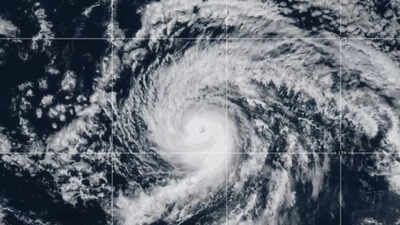ARTICLE AD BOX

Hurricane Kiko, once a Category 3 storm, has weakened to a Category 2 as it churns across the Central Pacific, prompting a state of emergency in Hawaii. While the risk of direct impact decreases, dangerous surf conditions are expected along east-facing shores. Residents are urged to prepare emergency kits and monitor official updates.
Hurricane Kiko, churning across the Central Pacific, has led to a state of emergency in Hawaii. Though the risk of the direct impacts on the island appears to be decreasing, it could bring potentially dangerous surf conditions.
How severe is Hurricane Kiko
On Sunday evening, Hurricane Kiko had dropped from a Category 3 to Category 2, with maximum sustained winds of 110 mph, located approximately 635 miles east of Hilo, Hawaii, moving west-northwest at 13 mph, according to the National Hurricane Center. “Risk of direct impacts to Hawaii from Kiko are decreasing with most areas seeing 5-10% cumulative probability of tropical storm force winds,” the forecasters said on Sunday, 11 am. “Swell generated from Kiko will build Monday and Monday night, peaking Tuesday, likely exceeding advisory levels and possible warning level surf along E facing shores,” they added.
Last week, Kiko intensified to a Category 1 hurricane in the eastern Pacific before weakening. On Friday, the state’s acting governor, Sylvia Luke, declared a state of emergency, activating state resources and the Hawaii National Guard to prepare for potential impacts from the storm.“The proclamation activates emergency measures and resources to protect public health, safety, and welfare. Tropical storm-force winds, heavy rainfall, and high surf associated with Hurricane Kiko could begin affecting portions of the state as early as Monday, September 8, 2025,” Luke’s office announced.
The government has urged residents and visitors to monitor updates, follow official guidance, and prepare accordingly.
The storm also comes at the end of Hawaii's bustling summer travel season.Safety measures
The Hawaii officials and NHC have recommended several steps to ensure safety as Kiko approaches. “Stay prepared, not scared. Disasters can strike without warning. Make sure your preparedness kit is ready,” they said. Prepare an Emergency plan It is important to be prepared before the hurricane hits.
- Note the emergency numbers: The CDC recommends writing down the emergency phone numbers and keeping them handy (on the refrigerator, or near every phone) in your house. Add those numbers to your cell phones as well.
- Prepare an emergency supply kit
- Locate nearest shelters: Also, plan different routes that can take you there.
- Pet owners should identify shelters, hotels where they can take their pets in case of an evacuation.
Stock emergency supplies
It is crucial to assemble a disaster kit with essentials like water, non-perishable food, flashlights, batteries, and first-aid supplies. Hawaii Emergency Management has recommended adding the following to your kit.
- Water supply: Water treatment system, filters/life straws/tablets, emergency drinking water (ReadyH20)
- Food supply: Ready-to-eat meals, freeze-dried meals, canned foods
- Power supply: Solar power source, generator, power bank, hand crank systems.
- Important documents: Identification and financial cards, vital records (property, medical), Critical documents (birth cert, legal docs)
Secure your propertyIt is also crucial that you reinforce windows, secure the outdoor items, and keep the valuables elevated to protect against potential flooding. If required to stay at home
- Keep your emergency supply kit in a place that is easily accessible.
- Listen to the emergency updates on the radio or TV if available.
- Stay indoors: CDC warns against going outside even if it looks calm. "Wait until you hear or see an official message that the hurricane is over. Sometimes, the weather gets calm in the middle of a storm, but then quickly gets bad again," the agency cautions.
- Stay away from the windows: Choose a room with no windows, if possible. This can help you to prevent getting hurt from broken glass or flying debris during the storm.
‘Wannabe Dictator’: Trump’s Bizarre Threat to ‘Occupy’ Chicago Triggers National Outcry
If evacuation is required
- Get your emergency supply kit: Remember to only take things that you really need, such as a cell phone, chargers, medicines, identification like a passport or license, and cash.
- Unplug appliances: Ensure to turn off the gas, electricity, and water, if you have time.
- Follow the roads that emergency workers recommend: Do not drive through flooded areas
- Contact your local emergency management service.



.png)
.png)
.png)
















 4 days ago
5
4 days ago
5









 English (US) ·
English (US) ·